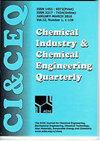树脂-中和耦合工艺处理不锈钢酸洗废水的研究
IF 0.8
4区 工程技术
Q4 CHEMISTRY, APPLIED
Chemical Industry & Chemical Engineering Quarterly
Pub Date : 2023-01-01
DOI:10.2298/ciceq221023007b
引用次数: 0
摘要
不锈钢工业造成的主要环境问题之一是生产过程中产生的废液。在HF和HNO3混合物、油和漂洗废水中含有高浓度的Fe (III)、Cr (III)、Cr (VI)、Ni (II)等金属离子。使用过的酸洗废液pH为0.5,总溶解盐(TDS)为520g/L,密度为1.20g/CC。目前的工作重点是利用过滤、树脂和中和相结合的方法回收酸洗废水,以有效去除金属离子和大于99.5%的F-。采用膜面积为0.2m2的微滤池和超滤池对TDS进行了去除实验。用TulsionFSMP 6301树脂去除Cr (VI),用NaNO3解吸,然后转化为副产物Na2Cr2O7。中和用Ca(OH)2、NaOH沉淀金属离子,用ZrOCl2抛光滤液,F-的有效去除率达到0.12 mg/L。硝酸被回收为NaNO3。利用实验数据对Cr (VI)进行了吸附等温线和动力学研究,并绘制了工艺流程图,最终可以在更大规模上进行测试。本文章由计算机程序翻译,如有差异,请以英文原文为准。
A resins-neutralization coupled route for the treatment of stainless-steel pickling effluent: A research study
One of the major environmental problems caused by stainless-steel industries is the liquid effluents generated during the production processes. It contains a high concentration of metal ions such as Fe (III), Cr (III), Cr (VI), and Ni (II) in HF and HNO3 mixture, oil, and rinse wastewater. The used pickling waste stream has a pH of 0.5, and Total Dissolved Salts (TDS) of 520g/L with a density of 1.20g/CC. The present work focused on the recycling of pickling effluent by applying a combination of filtration, resins, and neutralization for the efficient removal of metal ions and F- greater than 99.5%. Laboratory experiments were performed using micro and ultra-filters with a membrane area of 0.2m2 for the removal of TDS. Cr (VI) was removed using TulsionFSMP 6301 resin and desorption using NaNO3 and subsequent conversion into Na2Cr2O7 as a by-product. For neutralization, Ca(OH)2, NaOH were used to precipitate metal ions and the resulting filtrate was polished using ZrOCl2 for effective removal of F- to 0.12 mg/L. The nitrate was recovered as NaNO3. Adsorption isotherm and kinetic studies were utilised for Cr (VI) from experimental data and a process flow diagram is developed, which can eventually be tested on a larger scale.
求助全文
通过发布文献求助,成功后即可免费获取论文全文。
去求助
来源期刊

Chemical Industry & Chemical Engineering Quarterly
CHEMISTRY, APPLIED-ENGINEERING, CHEMICAL
CiteScore
2.10
自引率
0.00%
发文量
24
审稿时长
3.3 months
期刊介绍:
The Journal invites contributions to the following two main areas:
• Applied Chemistry dealing with the application of basic chemical sciences to industry
• Chemical Engineering dealing with the chemical and biochemical conversion of raw materials into different products as well as the design and operation of plants and equipment.
The Journal welcomes contributions focused on:
Chemical and Biochemical Engineering [...]
Process Systems Engineering[...]
Environmental Chemical and Process Engineering[...]
Materials Synthesis and Processing[...]
Food and Bioproducts Processing[...]
Process Technology[...]
 求助内容:
求助内容: 应助结果提醒方式:
应助结果提醒方式:


